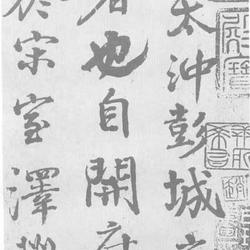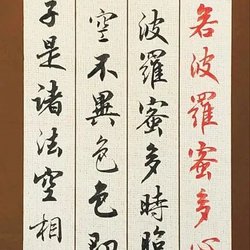
The complete ink collection of Fusuki Nakamura, Japan
This copy was signed on August 28, the first year of Jianzhong (780). Regular script, paper version, one announcement, 33 lines, 255 words in total. The ink copy was once collected in the Nakamura Fusaki Calligraphy Museum in Japan.
This post is also known as "A Self-written Report from the Prince's Young Master", which is said to have been written in ink by Yan Zhenqing, followed by postscripts by Cai Xiang, Mi Youren and Dong Qichang. Cai's postscript: "Lu Gong resigned in the last year of his life, and the loyal and virtuous people could not be seen. Cai Xiang of Puyang fasted to watch until October 23rd of the second year of He." Mi's postscript: "Youyan Zhenqing wrote his confession. On the fourth day of the ninth year of Shaoxing On the seventh day of the lunar month, Mi Youren respectfully read and reviewed it." This post was collected by the Imperial Household of the Song Dynasty, and later by Han Zhou, Jia Sidao, Fengxi of the Ming and Han Dynasties, Qingbiao and Anqi of the Qing Dynasty, and the Imperial Household of the Qing Dynasty, and was later given to them. Prince Gong Yi. There are seals such as "Shaoxing", "Secretary's Seal of the Inner Palace", "Anqi's Seal", "Qianlong Yulan" and "Prince Gong's Seal". There are six words in front of the post: "Announcement from Tang Yan Zhenqing" written by Emperor Qianlong. Following the postscripts of Cai and Mi, there is also the postscript of Dong Qichang: "There are many copies of official reports in the world, but in the Tang Dynasty, there were very few people like Yan Pingyuan. There are also very few such ancient and heroic volumes in Pingyuan. Mi Yuanhui and Cai Junmo have already appreciated them. Yes, I have a word of praise. Dong Qichang." This post has been recorded in "Yun Yan Guo Yan Lu" and "Qinghe Painting and Calligraphy Boat". The rubbing of "Zhongyi Tang Tie" carved by Liu Yuan in the Southern Song Dynasty is the earliest engraving found. Later generations of Cong Tie , Huike also earns more. Because "Gao Shen" has been circulated and recorded, and has been engraved in series of posters and recorded in some calligraphy and painting classics, it has always been regarded as the authentic work of Yan Zhenqing. However, after research, Cao Baolin and Zhu Guantian believed that this post was not authentic. Qi Gong believes that "it is difficult to understand the truth if you write and tell by yourself" (self-notes to the forty-nine poems in "One Hundred Quatrains of Qi Gong's Theory of Letters").

Part of the ink book collected by Fusuki Nakamura, Japan




















